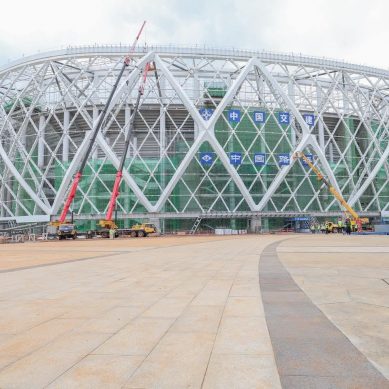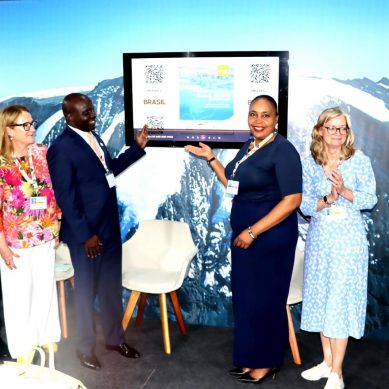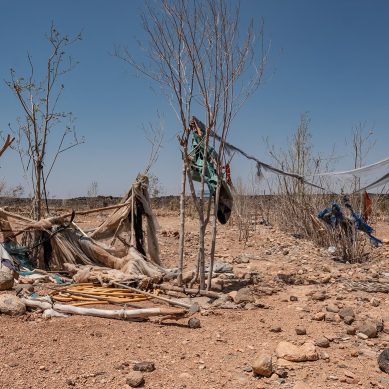
A donkey cart rattles down a sandy track that winds between thorny trees in Senegal’s Ferlo valley. Its passengers jolt with every bump as it passes a broken metal gate that once controlled access to this arid land near the small village of Koyli Alpha.
The gate, along with kilometres of wire fencing, was erected here in 2012 to protect thousands of acacia saplings, planted to re-green the plot of 600 hectares.
But 13 years later, the plantation is indistinguishable from the surrounding landscape. The barbed wire lies collapsed in the dust. After the fencing broke and there wasn’t enough money to repair it. goats grazed on the plants until the soil returned to dust and sand.
Only a rusted sign remains. Its large green lettering the last reminder that the plantation once belonged to a dream larger than life: Africa’s Great Green Wall.
As world leaders gather in Brazil for COP30, where funding from industrialised countries to poorer nations to protect their forests will be a key discussion point, the Great Green Wall initiative could offer some lessons.
Originally conceived by Thomas Sankara, Burkina Faso’s late revolutionary leader, the Great Green Wall was launched in 2007 by the African Union. Its goal: to slow desertification in the Sahel region by planting a “wall” of trees 8,000 kilometres long and 15 kilometres wide – from Senegal to Djibouti.
The Great Green Wall initiative originally covered 11 core countries in the Sahel-Sahara region, but has been expanded to include up to 35 countries on the continent.
By 2030, it aims to have re-greened 100 million hectares of land, captured 250 million tonnes of CO2 and created 10 million “green jobs”. It was touted as an African-led solution to many of the Sahel’s problems, from migration and conflict, to poverty and hunger.
Five years away from its self-imposed deadline, billions of dollars have been spent and billions more pledged, yet most of the Great Green Wall remains barren. Countless projects have floundered, and the African agencies tasked with overseeing the initiative say they have been largely side-lined by the international donors funding it.
A symbol of pan-African cooperation, critics say, has become yet another cautionary tale for the limitations of top-down international aid in Africa
“Where is this money going that is announced every year but doesn’t reach us?” said Kodou Choukou Tidjani, sitting in the run-down offices of the Great Green Wall’s national agency, in Chad’s capital, N’Djamena. Each of the 11 countries taking part in the Wall has its own agency, responsible for managing progress on the ground and reporting back to the pan-African coordinating body in Mauritania.
In 2021, Tidjani looked on as French President Emmanuel Macron announced at the One Planet Summit that an additional $14.3 billion had been pledged to the Great Green Wall by donors, including the World Bank, the Green Climate Fund, the European Union and others. Yet he claims his agency has seen almost none of it.
“Neither from the COP nor the One Planet Summit, Chad has never received a single franc to support this mission,” said Tidjani.
For him, funding for the Wall should be seen as “reparations” for climate change’s disproportionate impact on the Sahel. Temperatures here are rising 1.5 times faster than in the rest of the world, fuelling resource conflicts and hunger. Yet in one of Africa’s largest and least developed countries – most of which is desert – Chad’s agency can barely raise enough money to visit its own project sites.
Through Freedom of Information (FoI) requests sent to the European Union, The New Humanitarian found that the EU has contributed over €1.54 billion in funding to the Great Green Wall in just three years between 2021 and 2023. Over €123 million of that went specifically to Chad.
But staff at Chad’s agency say this money often bypassed the agency altogether, and instead went directly to international NGOs or other organisations running their own Great Green Wall projects – making it nearly impossible to track what’s happening on the ground.
In 2023, two years after Macron’s big announcement at the One Planet Summit, a collective of scientists warned that the Great Green Wall was turning into “a form of green neo-colonialism” and accused Macron of “confiscating it from African states”.
“Across the ocean, they only make announcements. They don’t give, but they still criticise,” railed Tidjani. “There’s a saying: The hand that gives, commands. But they don’t give – and they still want to command.”
Annah Zhu, an assistant professor of environmental policy who recently published a large-scale study on the Great Green Wall, argues that even when funding does come to the national agencies, the need to cater to international funders means it often prioritises projects that fit into a “Western imaginary of Africa”, such as tree-planting and the creation of fenced reserves.
Back in Senegal, a few kilometres from the wilted plantation outside Koyli Alpha village, another fence marks one of the Great Green Wall’s more recent projects: the Koyli Alpha Community Wildlife Reserve.
The reserve was established in 2017 with funding coming from the EU, the UN’s Food and Agriculture Organization and the Canadian government – with at least 25 million Canadian dollars (€15.3 million). Rewilding efforts have brought about 30 oryx and 18 tortoises into the fenced-off reserve.
“When the project came, the population welcomed it with open arms,” said a uniformed guard, who seemed slightly surprised to have visitors.
The reserve, he explained, has brought some tangible benefits: a tap where locals can collect drinking water, and fodder for livestock sold at a reduced price during the lean season – the grass here is noticeably higher than outside the fence. Beyond that, however, the promises seem to have largely fallen flat.
Communities were told the reserve would become an eco-tourism hub but apart from a few game viewing platforms, the area lacks any other necessary infrastructure like a proper road or accommodation. The tourism boom hasn’t materialised. And while the reserve was meant to be community-managed, locals can no longer access the land with their cattle.
Funding, too, barely trickles in. The project used to employ 10 people, but now only three men work at the site, said the guard. They even have to use their personal motorbikes to patrol the reserve. “For five years, they’ve promised they would build a guard post,” he shrugged. But despite the millions in funding, on the day The New Humanitarian visited, he and his colleagues were sitting under an acacia tree, exposed to the elements.
The project has been beset by controversy since its inception, with a previous attempt to establish the reserve in another area aborted after the local pastoralist community rejected the idea of tourists coming to gawk at animals on land needed for grazing their livestock.
Some of the New Humanitarian’s FoI requests into the project, including how the money was spent and any negative impacts on the community, were denied by the European Commission on the basis that the information disclosure “would undermine the public interest as regards international relations”.
In their study, Zhu and her colleagues found that only one out of 36 reforested plots in Senegal showed any significant re-greening, and that the projects brought minimal benefits for either the environment or local communities.
“The Great Green Wall is more Western-driven than African-led,” said Zhu. “Its power is its ability to attract funding in Europe and the United States. The problem is that’s all it does.”
Her co-author, Professor Amadou Ndiaye, a researcher at Amadou Mahtar Mbow University in Dakar, explained that many of the projects implanted in the Ferlo are simply repeating centuries-old tropes of trying to settle down semi-nomadic pastoralists by building fences and reserves.
“Pastoral practices in the Ferlo Valley date back thousands of years. During colonisation, the French wanted to settle pastoralists around boreholes. That didn’t work either,” he said.
“There are traditional ecosystem conservation systems, but they haven’t been well studied and exploited because they don’t mobilise a lot of money,” Ndiaye added.
Along the length of the Wall, projects have failed because of poor planning, inadequate funding or the restrictions of having to work within the funding cycles and requirements of international donors, researchers note.
On the other side of the continent from Koyli Alpha, in southern Djibouti, Momina Seid remembers how optimistic she felt six years ago, when government workers came to her village of Ab’Aydu and told the local women’s cooperative to start working on two hectares of farmland. The plot had been earmarked for Great Green Wall funding, they said.
The cooperative had been running a small one-hectare vegetable farm irrigated by a borehole, but there never was quite enough water for it to thrive.
Now Seid was once again filled with hope. “The government told us to get together and work,” she remembers. “We were told we would have water. We wanted to grow forage for our goats, and maybe food for our families. We were even thinking of selling some produce.”
The women threw themselves into the gruelling work of preparing the new plot on a barren, rock-strewn hillside. It took them five months to clear the land, hauling away thousands of rocks in empty rice sacks and stacking them like a barricade around the field.
Soon the government contractors arrived and began drilling the borehole. Then, as Seid recalls it, one day they just disappeared and never came back. Nobody ever told her why. Without the new borehole, and with the old one now providing barely enough water to sustain local livestock, the women’s dreams fell apart.
The head of Djibouti’s Great Green Wall agency, Abdulfatah Arab, confirmed an all-too-common problem: The budget had run out, and until they managed to secure more international funding, the women’s cooperative would have to wait. Arab said his agency has received barely 10 per cent of the funding it had been expecting.
In the meantime, Seid and her partners say they’ve heard nothing.
“There are people who come and ask questions,” she said, sitting in the comparative cool of her family’s storeroom, on a hillside overlooking the dusty highway to Ethiopia. “But nobody has yet encouraged us or told us to hang on. There’s no water left. The land has been dry for a year.”
For now, a broken fence and a few lifeless trees are all that remain of their farm.
- A Tell Media report / By Julie Bourdin, Tommy Trenchard and Maya Misikir
Edited by Obi Anyadike.







